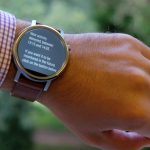 Smart watches and other wearable devices have become increasingly powerful in the past few years, with a wide range of potential applications, from quantified self style fitness tracking to bona fide medical research. A team from the University of Sussex believe they’ve developed an algorithm that allows smartwatches to monitor every move we make, even when not told specifically what to look for.
Smart watches and other wearable devices have become increasingly powerful in the past few years, with a wide range of potential applications, from quantified self style fitness tracking to bona fide medical research. A team from the University of Sussex believe they’ve developed an algorithm that allows smartwatches to monitor every move we make, even when not told specifically what to look for.
The smartwatches on the market today are great at measuring a relatively narrow range of activities, but they typically require each activity to be programmed into the device in advance. The researchers believe their new method allows the watch to autonomously discover activities as they occur without requiring such pre-programming. This flexibility allows the device to capture everything from making lunch to brushing your teeth. It’s even capable of tracking sedentary activity.
“Current activity-recognition systems usually fail because they are limited to recognising a predefined set of activities, whereas of course human activities are not limited and change with time,” the team say.
The new approach, which is documented in a recently published paper, uses machine learning to detect the wearer’s activity in real time. It’s an approach that the team believe outperforms competing approaches.
Most existing devices use models that cluster bursts of activity together to estimate both what the person was doing, and also how long they were doing it for. For instance, if the device records a large number of continuous steps, this is usually clustered together into a walk. Where this approach often falls down however is that it fails to account for pauses or interruptions, therefore a walk that was interrupted with a couple of breaks would be classed as three distinct walks.
Transitions
Central to the approach is a close attention paid to the transition between activities as to the activity itself. For instance, in the walking example above, the method would notice that the walk continues after each break and therefore it would hold the data while it waits.
“Future smartwatches will be able to better analyse and understand our activities by automatically discovering when we engage in some new type of activity,” the authors say. “This new method for activity discovery paints a far richer, more accurate, picture of daily human life.”
The team are confident that this new breed of tracking devices will not only provide a boost to those of us monitoring our fitness, but also significantly supporting the healthcare industry, and potentially even consumer research too.